TRAVEL
GUIDE
|
Corralejo
Weather
Fuerteventura Accommodation
|
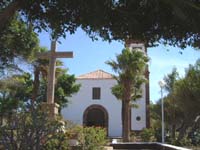 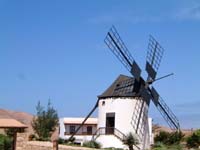
|
|
A peaceful town, head of the
municipality of Antigua towards the very center of the island. The two
main attractions in this town are the church, dedicated to the "Virgen
de la Antigua" (above left) and the artesian center (above right). The
church was constructed in 1785 and is often open to tourists during the
morning and late afternoon. The artesian center and mill houses a local
museum and workshop where souveniers can be bought along with local
crafts.
Antigua itself was built in the 18th
century, making it one of the oldest towns on the island. In 1812 and
again from 1835 to 1836, it was regarded as the capital of
Fuerteventura. A perfect example of the relaxed way of life there can
be observed once a fortnight as locals gather in the church hall to
settle local disputes. For the villagers, the other main attraction is
the cultural center, home to the town's folklore group, music studio
and where the local film producers gather to make their own films.
In May or June of each year, folklore
groups and craftsmen gather near the artesian center to show their
skills and sell their products. A special area - which is otherwise
dedicated to a weekly market visited by much of the island - is used on
the estern edge of the town where there is also a swimming pool,
football field, gym and basketball court.
|
|
Betancuria
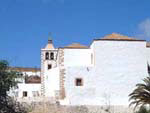
|
|
The old capital of the island, founded
in 1405 by the conqueror Jean de Bethencourt. The church of Santa Maria
was completed in 1426 though in 1593, it along with much of the town
was reduced to rubble as the pirate Jaban attacked. The church was
rebuilt in 1691 and the town remained the capital until 1834.
Once a fertile region, the drying up
of the land and natural streams that ran through this valley means
today's Betancuria survives almost entirely from the tourist trade. The
restaurant Casa santa Maria and the two adjacent craft shops are
perfect examples of the traditional architecture in the town's historic
quarter. Also in this quarter, as well as the cathedral itself are a
bodega and workshops where you can watch local artists at work.
(Restaurant open daily 11:00 - 18:00 - craft and shops open daily 11:00
- 16:00).
The cathedral has now become a museum
with a display of photographs documenting all the sacred buildings on
Fuerteventura along with religious objects and attractions located on
the island. Also on display are archeological finds.
Also on the "to visit" list here are
the ruins of the local monestary which was abandoned in 1937 upon
orders of Queen Isabella II of Spain. The roof of the monestary was
sold for food, grain and water because of droughts. The monestary's
church of San Buenaventura still stands and though empty (and locked)
inside, the outside has been restored.
|
|
Corralejo
 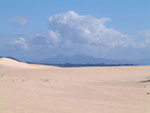
|
|
Perhaps the most well known of
Fuerteventura's towns as this is now the islands largest and busiest
tourist resort. Vast demands of tourism means the resort is ever
changing and growing. Most of the resorts restaurants, bars and shops
are lined along the main street that runs down into Corralejo and
ending in a maze of small streets by the seafront. It's here by night
that the livlier restaurants and bars are with live music each night in
the square found there, along with more traditional restaurants hidden
in the smaller side streets.
Along the main street as you enter the
resort, there's a daily market selling everything from local produce to
souveniers and in the same location, popular early in the evenings is a
childrens play area with small rides, playground and bouncy castles.
The harbour - as well as home to the
local fisherman and yacht owners and day-cruise ships, it is also port
of call for ferry services; an hourly service to the neighbouring
island of Lanzarote, just 35 minutes away.
Directly behind Corralejo is a
protected (since 1960) nature park which is a vast area of golden sand
dunes and ideallic beaches. There's quite a selection of beaches along
the edge of the dunes, some ideal for families, others for naturists
and others popular with windsurfers.
|
|
Caleta de Fuste
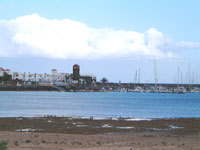
|
|
Just a little south of the island's
airport and the capital, Puerto del Rosario.
Other than the old fort that still
stands here, the remainder of the resort is purpose built for tourism
and on the outskirts, lots more building work going on as Caleta de
Fuuste rapidally expands. Almost completed is the islands only 18-hole
golf course. There is an open-air museum to visit that consists of
saltworks and lime-burning kilns.
Plenty of bars and restaurants, good
nightlife, excellent watersports, a harbour make this an ideal holiday
destination.
|
|
Costa Calma
The first hotel was built here in 1977
and other than a few, private residences, little else until 1984 when
the main road pasing through the resort was completed. From that point
onwards development boomed. Now, as well as a vast choice of hotels and
complexes along the coast there's a good choice of resataurants and
bars in the small commercial centers. Desalinated sea water and water
recycling means this resort has become a green paradise complete with
pice forests.
Most famous here though are the
beaches, mile-upon-mile of golden sand and turqoise waters with the
most spectacular beach on the island - Playa de Sotavento - just a
short taxi ride away or long stroll along the seafront.
The nearby windfarm produces 15% of
the island's power and as developement continues a marina is planned.
|
|
El Cotillo
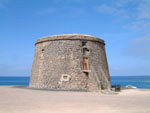
|
|
Another peaceful town unspoilt by
tourism whilst accommodating the trade with its many restaurants and
bars.
The church of this town is dedicated
to the Virgin of the Happy Journey - probably named so as a good-luck
charm for the locals who used Cotillo as a smuggler's harbour, shipping
off goods to the neighbouring islands without paying tax or duty and
smuggling other goods on to the island. The castle here was built in
1743 as a watch tower against attacking pirates, in particular the
English.
As you walk along the sandy beach
towards the lighthouse you will note the strong winds and surf here
make it a paradise for windsurfing.
Rumour has it that this is the next
part of the island to be developed for tourism, starting around El
Aljibe de la Cueva.
|
|
Jandia
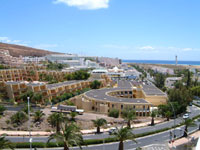 
|
|
Not quite a purpose-built resort as
once a tiny fishing village stood here. Engulfed now in the hotels and
apartment complexes that really form Jandia, it's the second largest of
the tourist resorts, thanks to the famous beaches of Fuerteventura
which are more spectacular in the south and especially Butihondo beach
at this resort. A walk along the beach could go on for 20km. The
lighthouse on the beach marks the southernmost point of the isnald. A
promenade runs the length of the resort, lined with restaurants, bars,
shops, commercial centers.
There's a harbour to the west towards
Morro Jable and as well as port of call for the fisherman, (fishing is
a very popular industry here) it's also port of call to ferry services
to neighbouring islands.
A new road is currently being built
from the airport to Morro Jable as the resort rapidly expands and new
developements are underway along the coastline.
|
|
La Oliva
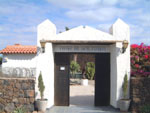
|
|
The capital of the island from 1836
onwards and another of the smaller, peaceful towns but with quite a bit
to see here. The military colonels built their residence here in 1708
and it still stands as one of the town's monuments with plans and a
grant to restore it in the very near future. If the caretaker decides
to work then he lets visitors look round the courtyard from 10:00 to
13:30. The building supposidly has 365 windows, go and count them
though 'cos I think a few less.
Casa del Capellan was home to the town
priest and the Casa Mane is a suprisingly pleasing museum of modern
art, well worth a look round, spacious with lots to see. Origionals
change from year to year with many being on sale to the public. (Open
10:00 to 17:00 - closed Sundays and holidays).
|
Pajara
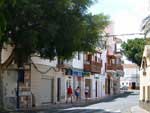
|
|
A fairly peaceful town, suprisingly so
when considering it's the headquarters for the largest municipality of
the island which includes all the tourist areas of the south. A farming
town, the houses are built in traditional style and have been carefully
restores through time. The church of Nuestra Senora de Regia was built
in 1687 and is perhaps the most beautiful on the island inside thanks
to the spectacular wall coverings.
|
|
Puerto del Rosario
With a population of around 20,000 and
the current capital of the island as from 1860 onwards. The origional
town is located around the harbour; there are narrow alleys and the
origional promenade to walk along, very quiet sidestreets and a choice
of small restaurants and bars. As you head away from the harbour the
town gets a little busier but the tourist resorts are more crowded than
the capital! Next to the Church of the Virgen del Rosario is the
island's court house and parliamentary buildings.
By night, the town is a place to go
for all forms of nightlife away from the tourist atmosphere of
Corralejo and Morro Jable.
|
|
|







